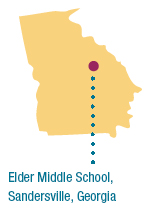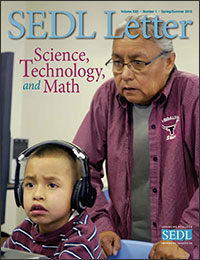A Plan for Success: Using Thinking Maps to Improve Student Learning in Georgia
The close of a school year often brings rewards for the months of hard work that have come before. Students who had previously struggled to multiply fractions or calculate a percentage may at last be solving such problems with ease—or at least more easily than before. Carla McNeely, a math teacher at T. J. Elder Middle School in Sandersville, Georgia, recently noticed such an improvement in some of her students' work. A few students who had been struggling, especially some of her students with special needs, were showing signs of beginning to master mathematical concepts that had once eluded them. The students had not yet taken the state assessment, but McNeely had been closely monitoring their progress and was seeing signs that more students were "getting it."
Georgia educators are hopeful that the progress McNeely is seeing in her students is part of a larger trend. Recently, 17 schools in the state were recognized for working their way off the Needs Improvement list, the status given to schools that do not meet academic standards under the No Child Left Behind Act of 2001 (NCLB). Perhaps most impressive about the accomplishment was that the schools had been under state direction, meaning they had been in Needs Improvement for 5 years or more.
This year, the staff and students at Elder Middle School hope to join these schools in leaving the Needs Improvement list. The school is implementing changes intended to lead to lasting improvement. Teachers are aligning instruction and tests with Georgia standards and elements—parts of standards that identify specific learning goals. They are closely monitoring student progress to identify areas where students are struggling and to provide support, either in class or through an afterschool program. And with the assistance of SEDL's Southeast Comprehensive Center (SECC), school staff have begun incorporating Thinking Maps®, a mapping process that helps students deepen their thinking skills and improve their understanding of subject matter across content areas.
Thinking Maps
Elder Middle School is one of 12 Georgia schools implementing Thinking Maps, with SEDL's assistance, as a school improvement strategy. Thinking Maps are visual teaching tools, such as Circle, Bubble, Double Bubble, Flow, Multi-Flow, Brace, Bridge, and Tree maps. The maps create a common visual language to help students organize information and learn content in all disciplines. After a few principals and district leaders implemented Thinking Maps with what seemed to be a positive impact on student achievement, the Georgia Department of Education investigated using the program in Needs Improvement schools as a way to focus on students. "After seeing where the department was going and what its needs were, and especially with the emphasis on reaching classrooms, Thinking Maps were a way to further the goals of the department and make an impact on classroom instruction, which is where you're really going to affect student achievement," says Glenda Copeland, who is the SECC's liaison with the Georgia Department of Education.
Examples of Thinking Maps

In this example, a Brace Map (left) is used to find the prime factors of the number 60. A Double Bubble Map (right) is used to compare prime factors and find the greatest common factor of 45 and 60.
In Summer 2009, some 1,200 administrators and staff from 27 schools received training from Thinking Maps staff. Attendees included some of the 17 schools that recently came off the Needs Improvement list. After a brief review at the start of the school year, teachers introduced Thinking Maps to students in the fall. SECC staff have since been supporting state directors in 12 of these schools as the directors lead teachers in implementing Thinking Maps. For example, SECC staff have visited the schools three times during this school year to model Thinking Maps in different academic content areas, collect data, conduct classroom walk-throughs, and provide feedback—depending on each state director's needs.
Camille Chapman and Concepción Molina, both math content specialists with the SECC, have been helping math teachers use Thinking Maps. John Newman, state director at Elder Middle School, describes the process: "The first time was more of a pulse check: What are you doing?  How is it working? That kind of thing," says Newman about Chapman's first visit. For her second visit, Chapman brought released items from the Criterion-Referenced Competency Tests, one of Georgia's mandatory assessments, and showed teachers how Thinking Maps can help students solve math problems that appear on the test. "That sort of thing was very, very helpful," says Newman, "because she brought something in that the teachers can actually use."
How is it working? That kind of thing," says Newman about Chapman's first visit. For her second visit, Chapman brought released items from the Criterion-Referenced Competency Tests, one of Georgia's mandatory assessments, and showed teachers how Thinking Maps can help students solve math problems that appear on the test. "That sort of thing was very, very helpful," says Newman, "because she brought something in that the teachers can actually use."
Teachers at Elder Middle School are still refining their use of Thinking Maps, but they are optimistic about the program's potential. "This year we're just trying to get our foot in the door," says Leslie Mathis, a math teacher at Elder. "But next year, it will be easier to incorporate Thinking Maps from the beginning." While the project is still new, both McNeely and Mathis have seen small victories. They describe using a Double Bubble Map to compare and contrast direct and inverse variations. "That really helped [students] put it all together," says McNeely. "They could see the main differences all on one sheet of paper, instead of having their direct [variation] notes here and their inverse notes there." Teachers are integrating Thinking Maps with other activities as well. The math department recently acquired interactive whiteboards, which have been a boon to Thinking Maps' popularity. "We did the same Double Bubble with direct and inverse [variations] on our [white]board, and the kids came up and wrote on the board," comments Mathis.
Teachers who double as instructors in the afterschool program are encouraging students to use Thinking Maps during tutoring. "[We do] anything we can . . . to get their understanding even deeper than it already is with the material we are covering in class," says McNeely.
Erin McCann, a SEDL Research and Evaluation program associate, is working with the Georgia Department of Education to develop a plan for evaluating the implementation and impact of Thinking Maps. With McCann's guidance, the group has outlined short-term, intermediate, and long-term outcomes. Because the schools have just begun using Thinking Maps, current evaluation efforts are assessing the degree to which teachers and students are using them. The State Department of Education is in the process of launching an online survey for teachers, administrators, school coaches, and state directors as one of the first steps in the evaluation. In August, McCann will help the department develop a plan for evaluating the impact of Thinking Maps. The evaluation will assess long-term outcomes, including improvement in students' classroom grades and standardized test performance. It will also look at whether there has been a long-term change in the culture of each school, with staff and students using the common verbal and visual languages supported by Thinking Maps.
A Plan for Lasting Improvement
Newman hopes that Thinking Maps and the other strategies Elder has adopted will have both short- and long-term benefits. If Elder meets academic benchmarks for the second year in a row, the school will leave Needs Improvement status. Newman will then move on to work with other schools. He expects the strategies adopted at Elder to outlast him, though. "Building capacity is exactly what we try to do," says Newman of the state directors' work. "We bring in initiatives and show them working, like Thinking Maps, monitoring student attendance, student data on testing, formative and summative assessment. All of these strategies should become part of the environment by the time I leave."
Last year, students at Elder Middle School surpassed the math achievement benchmarks set for the state assessment. As this school year draws to a close, staff have high expectations. It is too early to know if they have met academic goals, but they have enjoyed small successes and adopted strategies— such as Thinking Maps—that they hope will bring about long-term improvement.
Next Article: Technology Training in Ysleta: SEDL's Researcher-Practitioner Relationships Pay Off

